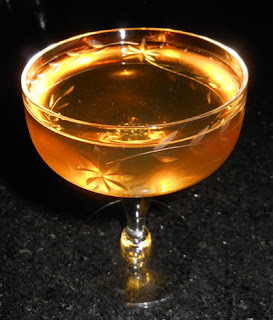2 part Zacapa 23 (3/4 oz)
2 part Fernet Branca (3/4 oz)
2 part Myer's Dark Rum (3/4 oz Gosling's Black Seal)
2 part Lime Juice (3/4 oz)
1 part Falernum (3/8 oz Velvet)
1 part Orgeat (3/8 oz BG Reynolds)
Shake with ice and strain into a cocktail glass. A
picture I later found on the web shows it being served in a mason jar filled with ice and garnished with mint sprigs, a lime wedge, and a straw.
Two Fridays ago, I was browsing the recipe book from Diageo's Cocktails from Around the World Happy Hour at Tales of the Cocktail last year. One appealing recipe that I did not try at the event was the Tar Pit from Clive's Classic Lounge in Victoria, British Columbia. While I missed the chance to have bartender Shawn Soole make me one, I was finally able to experience the drink described as "an Antiki (Anti-Tiki) cocktail showing that Tiki drinks can take many forms." I found the drink's subtitle to be a little odd especially considering that
Imbibe Magazine found Clive's to be one of the
top 10 Tiki bars. I am not sure what rums Clive's regularly uses for the Tar Pit; here, they opted for two dark rums from the Diageo portfolio to appease the sponsor.

With dark rums, lime juice, and Fernet Branca, the recipe for the Tar Pit reminded me of the
Dirt'n'Diesel. Like that drink, the aroma began with the Fernet Branca and aged rum notes. On the sip, the lime juice countered the caramel notes of the dark rums. The rums continued on into the swallow along with the Fernet Branca botanicals interacting with the tart lime; moreover, the orgeat syrup acted with the rum to smooth out the flavors on the swallow. Strangely, the drink smelled more intensely of Fernet Branca than it tasted. Indeed, Andrea commented that "It's a nice Fernet drink -- the Fernet is not being a surly prick"; the surly prick part was a reference to a comment Paul Clarke made about the liqueur in a post on the
Appetizer à l’Italienne.







 3/4 oz Aperol
3/4 oz Aperol



 1 oz Dry Gin (North Shore Distillers No. 11)
1 oz Dry Gin (North Shore Distillers No. 11)



































 The 2017 collection of 855 drink recipes, bartender tributes, and essays on hospitality from CocktailVirgin's Frederic Yarm. Available at
The 2017 collection of 855 drink recipes, bartender tributes, and essays on hospitality from CocktailVirgin's Frederic Yarm. Available at  The 2012 collection of 505 drink recipes, techniques, and Boston bar recommendations from Frederic Yarm. Available at
The 2012 collection of 505 drink recipes, techniques, and Boston bar recommendations from Frederic Yarm. Available at 



